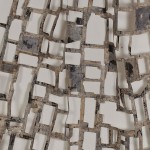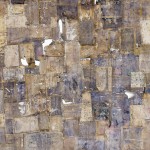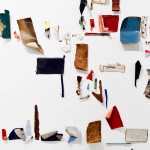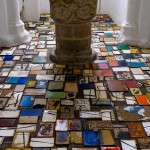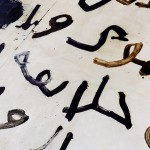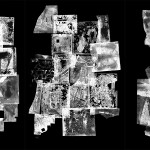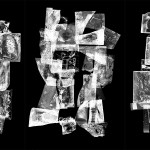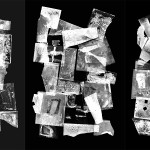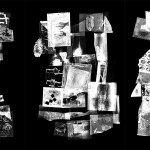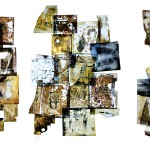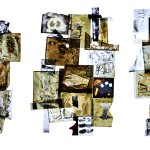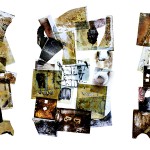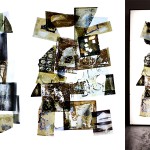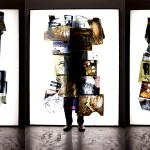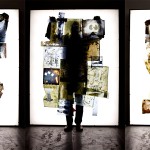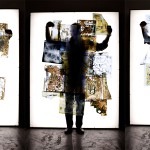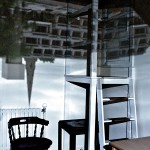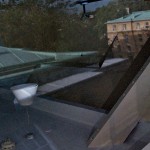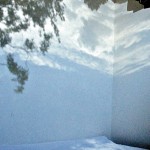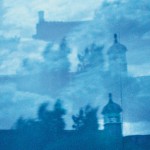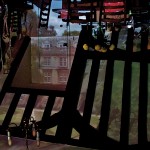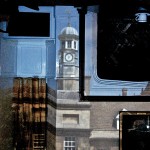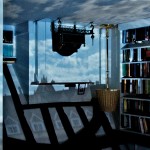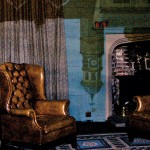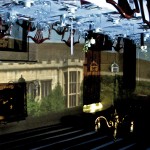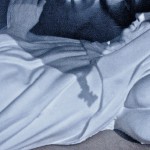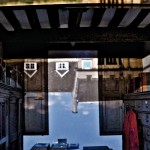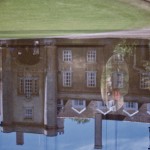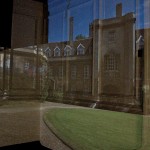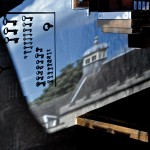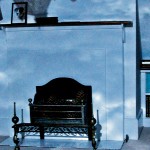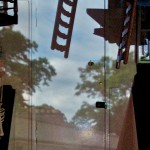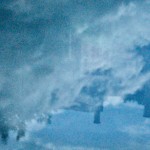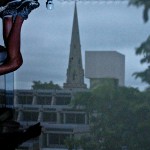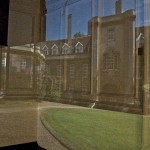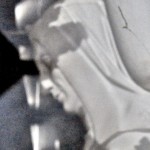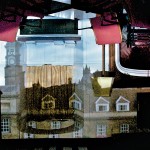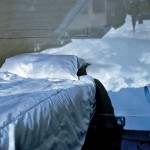P21 gallery presents Unearthed, a solo exhibition by Syrian-born, UK-based artist Issam Kourbaj, inspired by three years of the Syrian Revolution. Deeply affected by the ongoing violence and huge numbers of casualties in his home country, Kourbaj has created numerous multimedia works. These range from unique, site-specific installations, using repurposed book covers, discarded poster fragments and camerae obscurae, to original works on paper and canvas.
Huffington Post
Diana Scarborough – THE ARTIST’S VOICE-ISSAM KOURBAJ
Monocle – The Monocle Weekly
menaprestige – Issam Kourbaj Depicts His Grief Over Syria
I left Syria, but never my memories of it. Revisiting them warms my heart. But when I remember my own childhood and think of what the children of Syria are going through today and how their memories and their homes and all the beautiful and fragile and delicate things that make up a child’s outer and inner life have been torn to pieces and are violently and suddenly buried in shattered fragments under the ground, hidden beneath the silent earth, it’s difficult for me not to feel a mixture of pain, shock and anger.
Over the last three years as a Syrian artist, I’ve been observing from a very painful distance the war machines and dictatorships of the 21st century eviscerating my homeland, its people, its society, its cities and villages, its past and present, its history and its memory.
I shudder to think of the heart-breaking number of Syrian children breathing destruction, or rather gasping for breath as the chlorine gas corrupts their young lungs. And of other children and their families being torn to pieces through gas bombs, car bombs and barrel bombs which are being used to silence the voice of the revolution and dissent, a revolution which broke the fear barrier and dismantled state censorship on all forms of expression.
Images of aerial bombardment of civilian neighborhoods, of deadly sniper fire and brutal street fighting, images of husbands, fathers, uncles, mothers and grandmothers, aunts and children dying. Stories of mothers pressured to marry off their daughters simply for the family to survive, photographs of children living in tents, crammed into apartments and hiding in villages and towns. Gruesome “unverified” images from amateur video footage uploaded daily to social networking sites with the Editor’s Notes: We are unable to independently verify the content of the video.
To bring all these to my studio (these moving images of the new norm in Syria) and to digest, respond and translate them into subtle form, with meaning and without anger, has been and still is a great struggle for me.
Unearthed is not a collection of images that will go viral, nor will it be rapidly shared for quick global consumption via social media.
My work is a quiet gesture, an archive to remember those who have been forgotten, and an invitation to ponder what the future might bring to what’s left of my people and of my country – ‘The country’ formerly known as Syria’ as it was painfully referred to in the February 23rd 2013 edition of the Economist Magazine.
With the conflict entering its fourth year, the largest humanitarian crisis in the world today, I fear for the displaced, uprooted and orphaned Syrian families and children. But I believe and hope that one day, with the help of all of us who care, they will be able find the lost pieces of themselves and start to rebuild a new Syria, whole and unbroken.
Issam Kourbaj May 2014
Unearthed is on show at Kettle’s Yard until 26 October 2014. On 9 October Issam Kourbaj will be in conversation with Kettle’s Yard Director Andrew Nairne, all proceeds will go to Médecins Sans Frontières. Find out more here.
Press
Slatethedisco – Issam Kourbaj at St Peter’s Church
The Times – I worry about family and friends in Syria
Kettles Yard – Invigilating in St Peter’s Church
Kettles Yard – Sitting with the souls of Syria
Syrian-born artist Issam Kourbaj is exhibiting exclusive recent works in order to raise money for Syrian mothers and their families. For the fortnight of 22 March to 7 April, Christ’s College Cambridge artist-in-residence Issam Kourbaj will be exhibiting his new art project, Excavating the Present in a former furnishing emporium in King Street, Cambridge. Here, in a space blessed with abundant northern light, he will present his haunting installation, which amalgamates X-ray images of the human body and of familiar animals with aerial photo graphs of British landscapes.
In it, images of animal and human bones hang beside images of the land observed from the sky. Fixed to a clothes-line, carefully weathered with acids, the images are eerie yet domestic, a reminder that the biggest mystery of all, death, surrounds us all the time. But this theme goes further and wider than memento mori. He has constructed, for our contemplation, outer and inner landscapes, a chronicle of the smallness and fragility of our bodies and the vastness of the land and sky that holds us and bears silent witness to us. Can the present be created from broken pieces of the
past? Can we find all the broken pieces so as, with them, to build something new? In view of the tragic events in Syria, the exhibition dwells on the fragility of life and offers hope that a bigger and better world may one day come to be.
Further Information
Changing Spaces – Review
Press
Oxfam
Flaneur – Excavating the Present by Syrian artist Issam Kourbaj
lomography.com – Excavating the Present: Artworks by Issam Kourbaj
This summer Issam Kourbaj, Christ’s Artist in Residence, ran a 2 week long photography project called ‘Intimate distances’, with two College Students Hannah Newton and Sophie Skarbek. This project aimed to experience the College in different ways and leave a lasting trace.
Christ’s College is full of beautiful landmarks which we walk past every day: the clock in first court, the Master’s Lodge, the Great Gate. These landmarks are outside and readily visible – others are less obvious, inside buildings or around corners. ‘Intimate distances’ sought to visit these more private spaces (such as Darwin’s room, the muniment room and Fellows and student rooms), to darken them and set up a pinhole in the room so that the outside landscape is partially invited in. The result was a juxtaposition of these inner and outer landscapes; a dialogue between public and private spaces; a conversation between light and shade.
The resulting catalogue consists of twelve images resulting from the project and twelve poetic / prose responses to those images.
With poetic / prose responses by:
Tamsin Astbury, Jack Belloli, Gale Burns, Tom Gilliver, Colin Higgins, Sarah Howe, Matt Kirkham, Helen Mort, Jamie Patton, Michael Squire, Carrie Vout and Daniel Wakelin.
Further Information
In the dark attic of my studio, a knot-hole in the boarded-up window projected a live image of the street and its people and vehicles on to the ceiling. This had been happening for years, unnoticed. Its discovery invited me to start research on a device at that time entirely unknown to me, the pinhole camera, and its natural extension, the Camera Obscura. Following up these revelations, I conceived a project called Last light first light, relying solely on light-sources, lenses and mirrors; this formed the basis of my Open Studio exhibit in 2004.


